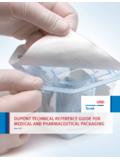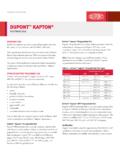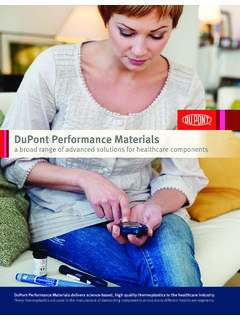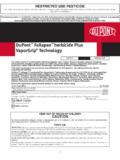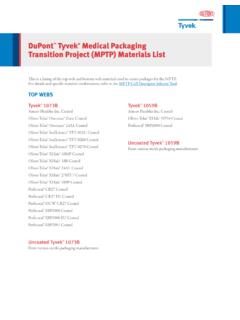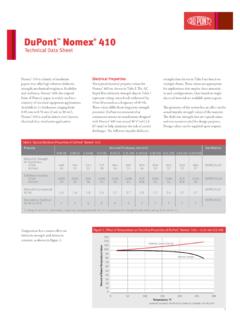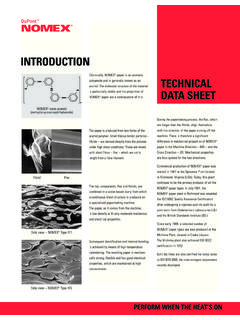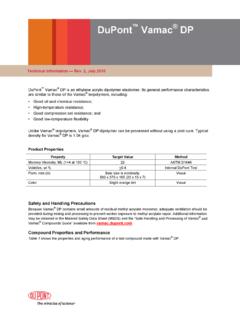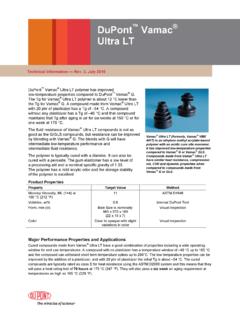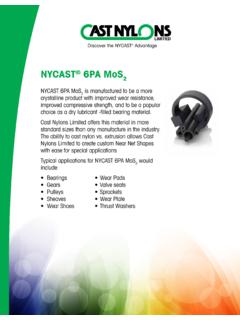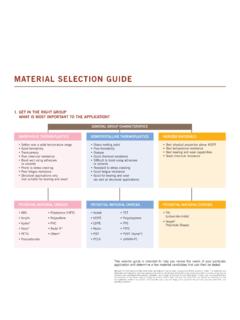Transcription of DuPont™ Selar® PA3426 Blends With Nylon 6
1 Selar PA For more information, e-mail us at: Selar PA3426 Blends with Nylon 6 General Information Resin Description Selar PA3426 is an amorphous Nylon (polyamide) resin that provides: zGood O2 and CO2 barrier, especially at high humidities zExcellent optical properties zMelt strength superior to that of Nylon 6 zWide range of processing temperatures zEase and flexibility of processing Blending even low percentages (20%) of Selar PA 3426 with Nylon 6, Nylon 66, and Nylon copolymers will result in a product that behaves like an amorphous polymer. These Blends retain all of the advantages of the Selar PA resin with some of the mechanical property advantages of semi-crystalline Nylon . Selar PA is suitable for a variety of packaging applications that require clarity, barrier, and processing flexibility. Because of the excellent barrier at refrigerated conditions, Selar PA 3426 and Selar PA 3426 Blends have benefits in meat and cheese packages, replacing the Nylon 6, PVDC, or EVOH barrier layer.
2 The amorphous nature of Selar PA 3426 makes this resin easy to extrude. Processing conditions ranging from 221 - 327 C (430 - 620 F) make it an attractive choice for co-extruded structures in film (blown and cast), extrusion coating, and sheet lines. Its thermoforming characteristics -- good drawability and uniform thickness in corners -- are excellent for both film and sheet. Selar PA 3426 is available in small, free-flowing pellets in 25-kg (55-lb) moisture barrier bags or 750-kg (1,653-lb) moisture barrier boxes. The resin can be processed by the same blown film, cast film, or cast sheet equipment used with semi-crystalline nylons. Selar PA 3426- Nylon 6 Blends can be made by dry blending. Safety At ambient temperatures, handling Selar PA barrier resin presents little hazard. The product has a low toxicity by ingestion and is neither a skin irritant nor a skin sensitizer. The resin should not be heated above 338 C (640 F). When overheated, decompositions with fume evolution may occur.
3 As with most plastics, use local ventilation to avoid exposure to fumes that may irritate the eyes, nose, throat, and upper respiratory tract. Take care to protect the hands and other exposed parts of the body when working with molten polymer. If molten polymer contacts the skin, cool the affected area with cold water or ice. Do not attempt to peel the solidified polymer from the skin. Obtain medical attention for thermal burn. Loose pellets should be swept up promptly to prevent falls. Disposal of scrap presents no special problems and can be by landfill or incineration in a properly operated incinerator. Disposal should comply with local, state, and federal regulations. For more detailed information on the safe handling and disposal of resins, an OSHA Material Safety Data Sheet can be obtained from the Regional Office serving you. The safety hazards common to all thermoplastic extrusion operations apply to Selar PA 3426 and Selar PA 3426 Blends and require standard, industry-accepted safety practice.
4 dupont places a very high priority on safety and believes all personal injuries can and should be prevented. The following protective measures should be considered: Page 1 of 11 dupont Selar PA3426 Blends with Nylon 69/10/2005 gloves and other protective clothing when handling hot polymer or operating machinery zWear approved safety glasses zUse adequate ventilation zUse accepted engineering designs and process controls zPromptly clean up any resin pellet spills FDA All grades of Selar PA comply with FDA regulation 21 CFR (a)(12) regarding food contact. Selar PA can be used with all types of food, except those with more than 8% alcohol. There is no FDA limitation on the temperature of the food or the thickness of the Selar PA in contact with the food. Physical Properties The following tables list typical properties of Selar PA 3426 and Selar PA 3426- Nylon 6 Blends . The choice of the type 6 Nylon will likely affect the properties of the Blends .
5 Capron 8207F from AlliedSignal or Ultramid B4 from BASF were used in the Blends in Tables 1 through 3. However, any non-nucleated Nylon 6 may be suitable. Selar PA film, both cast and blown, is transparent. Haze below 1 - 2% is virtually as clear as glass. The index of refraction of Selar PA 3426 is for 1-mil film, while container glass is The optical properties of Nylon 6 depend on process: Nylon 6 blown film is hazy; Nylon 6 cast film is transparent. Adding Selar PA 3426 to a type 6 Nylon will improve the optical properties (see Table 2) Table 1 - Selar PA 3426- Nylon 6 Blends , Polymer Properties aCapron 8207F Type 6 Nylon is a registered trademark of Allied Signal, Inc. Table 2 - Selar PA 3426- Nylon 6 Blends , Optical Propertiesa a1-mil blown monolayer film bCapron 8207F Type 6 Nylon is a registered trademark of Allied Signal, Inc. % Selar PA 3426 in BlendPropertyUnit0a20305080100 Density, D1501 , Dry C( F)70(158) 79(174) 84(183) 94(201) 112(234) 125(257)Melt Flowat 275 C(527 F) at 2160g 241920121115IV(m-cresol) Selar PA 3426 in BlendPropertyUnit0b20305080100 Gloss, D2457 Cast20 110 3011516313390 Blown20 20160150150130130 Haze, D1003 Cast Total < < < < < Total < < < < , D1746 Cast 556060705070 Blown 107570808070 Page 2 of 11 dupont Selar PA3426 Blends with Nylon 69/10/2005 Table 3 - Selar PA 3426- Nylon 6 Blends , Typical Film Propertiesa a1-mil blown monolayer film bCapron 8207F Type 6 Nylon is a registered trademark of Allied Signal, Inc.
6 CNo yield detected *X-Head 2 in/min *Jaw Separtion 4 in Barrier Properties At wet conditions, 95 - 100% RH, Selar PA 3426 is an excellent barrier to oxygen, carbon dioxide, and water vapor. It is equivalent to the EVOH oxygen barrier at the same wet conditions. At dry conditions, 0 - 5% RH, Selar PA 3426 is a good barrier. At 0% RH, oxygen and carbon dioxide barrier properties are the same as for Nylon 6. At 95 - 100% RH, the oxygen and carbon dioxide barrier of Selar PA is substantially better than that of Nylon 6 (see Figures 1 and 2). The moisture barrier properties of Selar PA 3426 and other resins are shown in Table 4. The barrier properties of Nylon 6 Blends fall between the performance of Selar PA 3426 and Nylon 6. However, as the humidity increases, adding even small amounts of Selar PA 3426 improves the barrier more than would be predicted by a straight-line correlation (see Figure 3 for OPV data and Figure 4 for WVTR). Table 4 - Moisture Barrier Properties 95% RH, 23 C (73 F) WVTR, g/100 in 2 day atm % Selar PA 3426 in BlendPropertyUnit0b20305080100 Elmendorf Tear, D1922g/milMD 313141341216g/milTD234755561214 Graves Tear, D1004g/milMD 430470425500920810g/milTD480500430490710 830 Spencer Impact, D3420in- Strength,* D882kpsiMD 3( ) 6( ) ( ) ( ) cc(kPa)TD3( ) 6( ) ( ) ( ) ccTensile Strength,* D882kpsiMD 6( ) 10( ) 8( )9( )7( ) 10( )(kPa)TD7( ) 10( ) 7( )9( )7( ) 10( )
7 Elongation*%MD 200390290360 20%TD210400310400 20 COFFilm/metal >1>1>1>1 Pin-hole Flex103 Cycles to FailMD F/35% RH 3 of 11 dupont Selar PA3426 Blends with Nylon 69/10/2005 1 Oxygen Permeation Figure 2 Carbon Dioxide Permeation Figure 3 Oxygen Permeation of Selar PA Blends with Nylon 6 at 95 - 100% RH Extrudable Selar PA 3426 4 of 11 dupont Selar PA3426 Blends with Nylon 69/10/2005 Table 5 - Oxygen Permeation of Selar PA Blends with Nylon 6a a1-mil blown monolayer film bCapron 8207F Type 6 Nylon is a registered trademark of Allied Signal, Inc. Figure 4 Water Vapor Transmission Rate of Selar PA Blends with Nylon 6 at 95 - 100% RH Table 6 Carbon Dioxide Permeationa % Selar PA 3426 in Blendcc-mil/100 in2day atm0b203050801000 C(32 F)0-5% C(32 F)95-100% RH C(86 F)0-5% C(86 F)95-100% RH in2 day atmNylon 6bDuPont Selar PA 34260 C(32 F)0-5 C(32 F)95-100 RH C(86 F)0-5 C(86 F)95-100 RH 5 of 11 dupont Selar PA3426 Blends with Nylon 69/10/2005 blown monolayer film bCapron 8207F Type 6 Nylon is a registered trademark of Allied Signal, Inc.
8 Table 7 Water Vapor Transmission of Selar PA Blends with Nylon 6a a1-mil blown monolayer film bCapron 8207F Type 6 Nylon is a registered trademark of Allied Signal, Inc. Figure 5 Rheology Curves for Selar PA 3426 Chemical Resistance The chemical resistance of various solvents is shown in Table 8. In general, Selar PA 3426 has good resistance to aliphatic and aromatic hydrocarbons, dilute alkalis, higher molecular weight alcohols, and low concentrations of lower molecular weight alcohols. End-use testing is recommended for each application, however. Table 8 Chemical Resistance of Selar PA 3426 % Selar PA 3426 in Blendg-mil/100 in2 day0b2030508010023 C(73 F)95 RH Mineral AcidsGoodDilute Aqueous Bases GoodAlcohols EthanolPoor IsopropanolPoor Ethylene GlycolFair GlycerineGoodHydrocarbons AromaticGood AliphaticGoodKetonesGoodEstersGoodAcetic AcidPoorPage 6 of 11 dupont Selar PA3426 Blends with Nylon 69/10/2005 the Resin Drying Selar PA resin is shipped dry (< moisture) in moisture-proof packages and can be used as received.
9 However, Selar PA resin does absorb moisture and should be re-dried if the bags have been opened, if the resin has been exposed to relative humidities of greater than 50% for 1/2 hr or more, or if the melt temperature will exceed 282 C (540 F). Typical drying temperatures are in the range of 79 - 96 C (175 - 205 F). If drying is needed, dehumidified hoppers or tray dryers that are capable of producing heated air with a dew point of -30 to -20 C (-22 to -4 F) are recommended. The dryer should be a regenerative-type, desiccant bed dryer with an exit air dew-point monitor. Typical drying temperatures are in the range of 82 -93 C (180 - 200 F) for tray drying and 71 - 82 C (160 -180 F) for hopper dryers. Figure 6 shows the time needed to dry Selar 3426 to moisture if dried at 88 C (190 F), the recommended drying condition. Thus, the more moisture in the resin, the longer it will take to dry. A 4-hr drying period at 88 C (190 F) is optimum for a resin containing water.
10 Figure 6 Selar PA 3426 Drying Time Curve Dry-Blending Blends of Selar PA 3426 with Nylon 6 can be made by dry blending prior to processing. Mixing should be done immediately before processing, in on-line mixers or in off-line mixers or shakers, provided the resin is not exposed to high humidities for greater than 1/2 hr. Consideration should be given to moderate mixing or barrier-type screws for production with dry- blend systems. Additives Selar PA 3426 has a slight yellow color when the layer or wall thickness exceeds 10 mil. The addition of a blue tint (00022531) at a ratio of 1% by weight of colorant will neutralize the yellow tint. The colorant also includes an antistatic agent to minimize Selar PA sticking to equipment walls. The film-to-film coefficient of friction of Selar PA and Selar PA Blends is very high. Therefore, an antiblock agent, 2% by weight of 1080096S, is recommended to reduce the coefficient of friction and help prevent film wrinkles.
